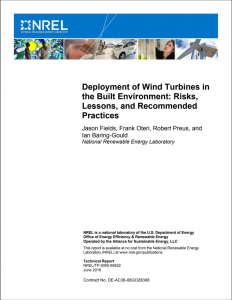Full Title: Deployment of Wind Turbines in the Built Environment: Risks, Lessons, and Recommended Practices
Author(s): Jason Fields, Frank Oteri, Robert Preus, and Ian Baring-Gould
Publisher(s): National Renewable Energy Laboratory
Publication Date: June 1, 2016
Full Text: Download Resource
Description (excerpt):
Built-environment wind turbine (BEWT) projects are wind energy projects that are constructed on, in, or near buildings. These projects present an opportunity for distributed, low-carbon generation combined with highly visible statements on sustainability, but the BEWT niche of the wind industry is still developing and is relatively less mature than the utility-scale wind or conventional ground-based distributed wind sectors. The findings from this report cannot be extended to wind energy deployments in general because of the large difference in application and technology maturity.
This paper investigates the current state of the BEWT industry by reviewing available literature on BEWT projects as well as interviewing project owners on their experiences deploying and operating the technology. The authors generated a series of case studies that outlines the pertinent project details, project outcomes, and lessons learned. This paper integrates those information sources into recommended practices that can be utilized by future stakeholders to evaluate the feasibility of BEWTs for their unique applications and sites. It should be noted that due to the lack of available information, the case studies were limited to building-mounted designs with limited coverage of building-integrated turbines (in which the architectural structure is shaped to support wind generation). The recommended practices are still largely applicable to any built-environment technology or approach.
Lessons learned from the case studies include the following:
• Project planning
o Project feasibility and planning processes are insufficient and not well defined. A few project developers undertook rigorous pre-construction planning, and those projects tended to have more positive outcomes.
• Project costs o Additional expenses related to installation and operations in the built environment can create high-cost projects.
• Project performance and reliability
o Consolidation of small turbine manufacturers has been common and can lead to loss of warranty and difficulty in service parts availability. o BEWT project performance is often over-estimated when compared with actual production. None of the case study projects met their energy production estimates, largely due to the complexity of conducting accurate resource and production assessments in complex built environments. Onsite atmospheric measurements are recommended, along with detailed loss calculations to account for real-world operating conditions.
In general, the BEWT industry has experienced mixed results, with some positive project outcomes and several negative outcomes for stakeholders. We see that projects with positive outcomes usually share the following commonalities: iv This report is available at no cost from the National Renewable Energy Laboratory (NREL) at www.nrel.gov/publications.
• Project goals have been well developed and quantified. These goals typically include some education or marketing component and do not rely solely on energy production.
• BEWT project developers conducted rigorous due diligence and devoted time to planning before deployment.
• BEWT projects are placed on taller buildings relative to surrounding obstacles (Encraft 2009).
• Project developers selected certified horizontal axis wind turbines (HAWTs) with a strong track record of previous deployments.
It should also be noted that based on several key factors (i.e., wind speeds are typically lower and costs for implementing projects in built environments are typically higher), projects in the built environment can be difficult to justify on a cost of energy or energy offset basis. Understanding the expected production of a wind turbine in the built environment is a very complex undertaking; the use of onsite resource measurements combined with high-fidelity models is likely the only way to understand the expected turbine production. While the BEWT industry is evolving, it appears that these projects are still an emerging wind energy application. Stakeholders considering a BEWT project should review the case study outcomes, lessons learned, and recommended practices to help inform their decision processes.
